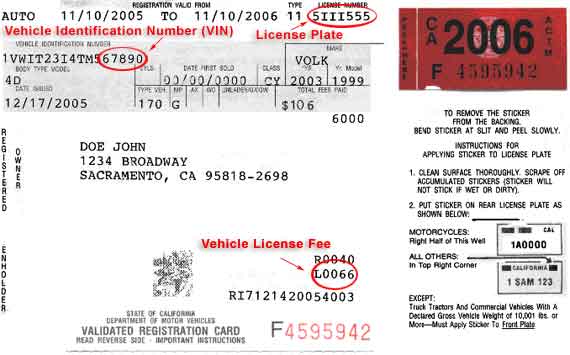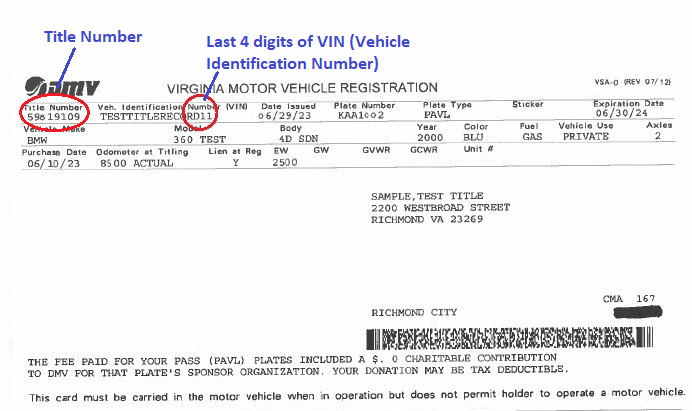A car registration typically consists of a document and a license plate with a unique number. The document includes the vehicle’s information and the owner’s details.
Navigating the specifics of car registrations can initially seem overwhelming, but it’s a straightforward process. Every vehicle owner must register their car with the relevant government authority, a step that’s as crucial as it is mandatory. This registration acts as a legal link between you and your vehicle, serving as proof of ownership and a right to operate the vehicle on public roads.
It generally includes essential data such as the make, model, and year of the car, the Vehicle Identification Number (VIN), and personal information about the owner like name and address. The design and information on registration documents may vary by state or country, but the purpose remains the same globally. Ensuring your car is properly registered is a key responsibility of ownership and is necessary for compliance with legal requirements.

Credit: www.carfax.com
Car Registration
Car registration is a mandatory process for car owners. It’s an official record with the government. This record links a car to its owner. It’s essential for driving legally on public roads.
Purpose Of Vehicle Registration
Vehicle registration serves multiple functions. It helps identify vehicles and their lawful owners. It also provides a way to tax vehicle owners. This money often goes into road maintenance and safety programs.
- Identification: A unique number plate links to your car’s registration.
- Taxation: Registration fees contribute to state revenue.
- Law enforcement: It aids in tracking down vehicles involved in violations.
Legal Implications
Not registering your vehicle has serious consequences. You could face fines or even have your car impounded.
- Fines: Driving without registration can lead to hefty penalties.
- Impoundment: Authorities can seize unregistered vehicles.
- Legal issues: You may be restricted from using your vehicle.

Credit: www.wheelsforwishes.org
Components Of A Car Registration Document
Understanding what a car registration document comprises is crucial for vehicle owners. This document serves as proof of ownership and legality on the road. Let’s break down the key components that make up this essential piece of paper.
Personal Details
The personal details section of a car registration document includes vital information about the vehicle owner. This part typically features:
- Full Name: The legal name of the vehicle’s owner.
- Address: The residential address where the owner lives.
- Contact Information: A phone number or email address.
- Signature: The owner’s signed consent, verifying the details.
Vehicle Information
The vehicle information section contains specific details about the car itself. Within this segment, you will find:
| Make and Model | The brand and type of vehicle. |
|---|---|
| VIN | The unique Vehicle Identification Number. |
| Registration Date | The day the vehicle was registered. |
| License Plate Number | The official number displayed on the car. |
| Expiration Date | The date when the registration needs renewal. |
Physical Appearance
The physical appearance of a car registration can instantly tell you a lot about its authenticity and validity. Let’s delve into the key features that define what a car registration looks like.
Standard Dimensions
Car registrations come in a size that’s easy to handle and read. Here’s a breakdown:
- Length: Typically around 6 inches (15.24 cm).
- Width: Usually about 4 inches (10.16 cm).
This size fits perfectly in a glove compartment or wallet.
Material And Durability
The material of a car registration card is crucial for its longevity. Here are the features:
- Material: Often made from high-grade paper or plastic.
- Finish: Cards have a protective coating to prevent damage.
This ensures the card withstands daily wear and tear.

Credit: www.dmv.virginia.gov
Security Features
Car registrations are crucial for identifying vehicles. Each document includes security features to prevent fraud. These features ensure each registration’s authenticity and integrity.
Anti-tampering Measures
Car registrations include several anti-tampering measures. These measures protect against unauthorized changes. Some common techniques are:
- Watermarks – Invisible unless held against light.
- Security threads – Embedded in the paper.
- Color-shifting ink – Changes color from different angles.
Counterfeit Prevention
Counterfeit prevention is key in car registrations. It stops illegal copies. Technologies used include:
- Microprinting – Tiny text that is hard to replicate.
- Holographic overlays – Adds a layer of security.
- UV printing – Visible only under UV light.
These features make car registrations hard to fake. They keep the vehicle and owner safe from fraud.
Information Display
The ‘Information Display’ on a car registration is a snapshot of essential details. It identifies the vehicle and its owner. This information helps authorities and service providers. It also plays a crucial role during transactions like selling or insuring a car.
Mandatory Fields
Every car registration features certain mandatory fields by law. These fields ensure the vehicle can be properly identified and linked to its owner.
| Field | Description |
|---|---|
| License Plate Number | Unique identifier for the vehicle |
| VIN | Vehicle Identification Number |
| Owner’s Name | Legal name of the vehicle’s owner |
| Owner’s Address | Legal address of the owner |
| Registration Date | Date when the vehicle was registered |
| Expiration Date | Date when the registration expires |
Optional Details
Apart from mandatory information, there are optional details. These are not required by law but can be included by the issuing agency.
- Type of Vehicle – Car, truck, motorcycle, etc.
- Color of Vehicle – Can help identify the vehicle quickly
- Gross Vehicle Weight – Important for commercial vehicles
- Lienholder Information – If the vehicle is financed
Variations Across Jurisdictions
Understanding car registration documents is crucial for vehicle owners. These important papers can vary widely depending on where you live. Here’s a look at how car registrations differ across the globe.
State-specific Formats
Each U.S. state issues its own car registration documents. This means the appearance and information included can be quite different from one state to another. Let’s explore these differences.
- California: Features a distinctive blue and red title, with a detailed description of the vehicle.
- Florida: Registrations include a watermark for security and a unique state-specific barcode.
- Texas: Uses a combination of printed text and security features to prevent fraud.
International Differences
When we look globally, the differences become even more pronounced. Many countries have their own systems and formats for vehicle registration.
| Country | Features |
|---|---|
| United Kingdom | Includes the DVLA watermark and a green slip for new owners. |
| Germany | Contains technical details and emissions information in a folded document. |
| Australia | Features a QR code for quick digital verification. |
Renewal And Expiration
Understanding the Renewal and Expiration of your car registration is crucial.
Renewal Process
Renewing your car registration is a simple process:
- Receive a notice from the DMV about upcoming expiry.
- Check any required documents and fees.
- Submit your renewal online, by mail, or in person.
- Receive your new registration and sticker.
Most areas allow online renewals. This method is fast and easy. Always check the DMV website for the most accurate information.
Consequences Of Non-renewal
Forgetting to renew your car registration can lead to problems:
- Legal issues: You might get fines or tickets.
- Service interruptions: You may face issues during vehicle inspections or renewals.
- Increased costs: Late fees can add to your expenses.
Always renew on time to avoid these issues. Set a reminder a month before your registration expires.
Electronic Registration Systems
Car registrations have gone digital, evolving beyond paper. Electronic Registration Systems transform how we view and handle these vital documents. Let’s explore the digital landscape.
Digital Formats
Today’s car registrations come in various digital formats. These include:
- PDF Documents: Secure and easily shared.
- Mobile Apps: Store and display registrations on smartphones.
- Online Portals: Access documents through official websites.
These formats ensure you always have your registration handy.
Access And Verification
Accessing and verifying car registrations is now a breeze. Consider these points:
| Online Access | Verification Process |
|---|---|
| Log in to a secure system. | Officials use special tools to check details. |
| View digital registration anytime. | Scanners verify barcodes or QR codes. |
| Download or print if needed. | Real-time data updates ensure accuracy. |
These systems protect your car’s legal status with ease.
Protecting Your Car Registration
Your car registration is a crucial document. It proves your ownership and legality on the road. Like your driver’s license, you must safeguard your car registration. Let’s explore how to keep this vital document secure.
Safe Storage Tips
- Keep it Hidden: Never leave your registration in plain sight. A locked glove box is a smart choice.
- Use a Sleeve: A protective sleeve can shield your registration from spills or tears.
- Home Storage: Consider storing a copy at home in a safe place. Only carry the original when necessary.
What To Do If Lost Or Stolen
- Report Immediately: Notify the police if your registration is stolen. This can prevent identity theft.
- Contact DMV: Reach out to the Department of Motor Vehicles. They will guide you through getting a replacement.
- Prevent Future Loss: Take steps to ensure it doesn’t happen again. Follow the safe storage tips above.
Conclusion
Understanding car registration documents is crucial for every vehicle owner. This guide has detailed what to expect visually and information-wise. Always keep your registration up-to-date to avoid legal issues. For further clarity, consult your local DMV or visit their website.
Safe driving starts with proper documentation.

Leave a Reply